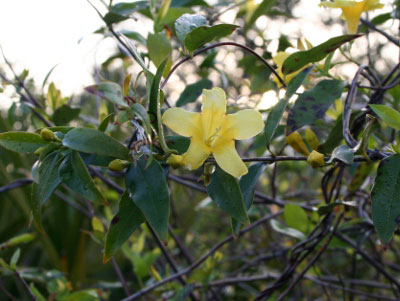Carolina Jessamine
This native vine blooms in late winter to early spring and is a lovely vine to train up fences, pergolas, and trellises.

As warmer weather creeps in, so do the cheerful flowers of Carolina jessamine, also called yellow jessamine.
Characteristics
In the wild, Carolina jessamine is typically found in open woodlands and along roadsides. Once temperatures rise, the treetops and hedgerows start twinkling with two-inch-long, yellow flowers. The trumpet-shaped flowers also put out a sweet fragrance, making the vine that much more attractive for pollinators and gardeners alike.
This native evergreen vine stays fairly bushy and compact when it’s grown in full sun. In shadier spots, it will climb up trees and shrubs as it tries to get closer to the sunlight, with the vines reaching up to 20 feet. The long and narrow leaves appear opposite each other along the wiry bronze stems.
In home gardens, it’s a great vine to use on arbors, trellises, and pergolas. It covers these structures quickly but is fairly easy to keep in bounds. It can also be planted as a ground cover and works well along steep banks.
Carolina jessamine is known scientifically as Gelsemium sempervirens. Home gardeners may wish to look for the popular double-flowered cultivar ‘Pride of Augusta’ (sometimes known as ‘Plena’) that features a longer blooming season.
Gardeners should know that the sap can be a skin irritant for some individuals and all parts of the plant contain strychnine-related toxins and are poisonous. Recent research suggests that the plant’s nectar may also be toxic to honeybees if gathered in large amounts.
Planting and Care
While it will tolerate some shade, plant Carolina jessamine in full sun for maximum flowering.
The vine is somewhat drought tolerant but will perform best if planted in a rich soil and watered regularly. If it gets too dry, it will drop some of its leaves but will usually bounce back once the moisture returns.
The plant tolerates frost and has few disease or insect problems. You can use a balanced fertilizer during the plant’s growing season, but take care not to overfertilize since this can reduce flowering.
For more information on Carolina jessamine, contact your county Extension office.
